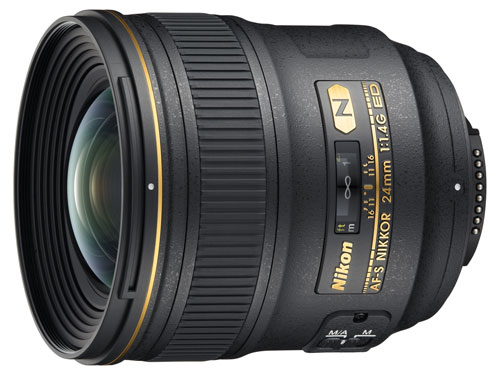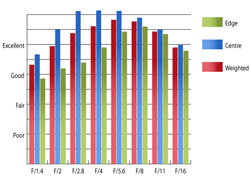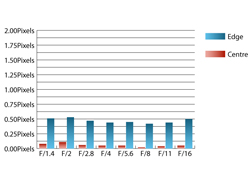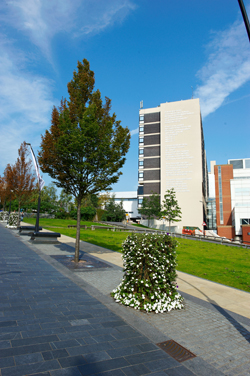Nikon AF-S Nikkor 24mm f/1.4G ED
 |
| Nikon's latest wide angle prime sports a bright maximum aperture of f/1.4, silent focusing and Nano-Crystal coatings. |
Nikon have been hard at work revamping their line-up of lenses over the past couple of years. Ever since the release of their first FX format camera, the Nikon D3, several of their professional lenses designed to cover the full-frame format have received a makeover. This lens isn't a makeover as such, but a completely new prospect from Nikon. Their closest match from the old lens line-up would have been the 28mm f/1.4, which was incredibly expensive and quite rare. A quick look on ebay reveals that the old lens is still capable of fetching over £2000 used!
This new optic still isn't cheap though, retailing at around £1900. For this you get professional quality build, a silent wave focusing motor, internal focusing and Nikon's Nano Crystal Coatings to suppress ghosting and flare. To put things into perspective, Canon's 24mm f/1.4L MkII costs around £1320, so is almost £600 cheaper.
The only third party alternative is Sigma's 24mm f/1.8 EX DG lens, which is two-thirds of a stop slower and is focused via the camera's focusing motor, which moves the whole optical system back and forth to achieve focus. This lens will only set you back a mere £405 though, which is under a quarter of the price of the Nikon optic.
Nikon AF-S NIKKOR 24mm f/1.4G ED: Handling and features
I expected this optic to be a lot larger and heavier than it actually is. It weighs only 620g, which is not that heavy for a lens of this aperture and build quality. While on the subject of the build, the lens feels very solidly put together. It is built to very fine tolerances and the exterior finish not only looks good, but feels reassuringly tough as well.
Focusing is performed internally by the Silent Wave Motor, or via the manual focus ring. Full time manual focus is possible, just in case you need to quickly grab the focus ring to adjust while in autofocus. In use I found the focus action to be lighting quick, although special care needs to be taken at maximum aperture as I found the lens would occasionally miss its target, At f/1.4 this really shows as the depth of field is really shallow at f/1.4, even on a 24mm lens.
I found the lens balanced well on the Nikon D700 used for testing, and even on a Nikon D300 I had handy, on which this lens provides the same angle of view as a 36mm lens.
Overall I really enjoyed using this lens. The handling is superb and the autofocus is very responsive.
Nikon AF-S Nikkor 24mm f/1.4G ED: Performance
During testing, this new wideangle optic from Nikon proved itself a very impressive performer, especially as far as resolution is concerned. At f/1.4 the lens already produces very good sharpness in the centre, and the quality towards the edges of the frame isn't too bad either. As it is stopped down the resolution increases across the frame, to superb levels, with peak sharpness across the frame being reached between f/5.6 and f/8. The levels of centre sharpness are so high between f/2.8 and f/5.6 that the lens out-resolves the sensor of the D700. D3X owners should take note! Diffraction doesn't seem to affect the performance of this optic as severely as with other wide angles I have tested, with results still being excellent down to the rather conservative minimum aperture of f/16.
Colour aberrations are kept below acceptable levels probably due to the use of ED glass in this lens. At every aperture the level of fringing towards the edge of the frame approaches 0.5 pixel widths. This level of CA will rarely pose a problem, only showing slightly in areas of extreme contrast towards the edge of the frame.
As is typical for wide aperture lenses such as this, falloff of illumination towards the corners is quite pronounced at f/1.4, with the corners being 2.77stops darker than the image centre. Illumination becomes more even as the lens is stopped down, but it doesn't appear even until f/4.
Barrel distortion is also present and is more pronounced at close distances. At distances of over a meter Imatest recorded 3.17% barrelling, which isn't an overly disturbing level, but may pose issues if straight lines are of absolute importance.
Just as with Nikon's other lenses sporting the new Nano-Crystal coatings, the 24mm f/1.4 is very resistant to flare and ghosting. A petal shaped hood is supplied with the lens, which does a sterling job of keeping extraneous light off the front element. Strong point sources of light in the frame may cause a slight loss on contrast and a little flare, but only in fairly extreme circumstances.
 | DxOMark provides objective, independent, RAW-based image quality performance data for lenses and digital cameras to help you select the best equipment to meet your photographic needs. Visit the DxOMark website for tests performed on the Nikon AF-S Nikkor 24mm f/1.4G ED. |
Nikon AF-S Nikkor 24mm f/1.4G ED: Verdict
Once again Nikon's revamp of their lens line-up has produced a new optic worthy of the professional gold-stripe designation. The build quality, focusing speed and optical quality are all superb.
It is a bit pricey though, especially for a lens many photographers will struggle to use as often as a zoom in the same range but if you shoot often in low light conditions using available light having a lens such as this in your armoury may pay dividends. For others it may prove too expensive to justify.
Nikon AF-S Nikkor 24mm f/1.4G ED: Pros
 Excellent optical quality
Excellent optical quality Fast focusing
Fast focusing Superb build quality
Superb build qualityNikon AF-S Nikkor 24mm f/1.4G ED: Cons
 Occasionally struggles to focus accurately enough for use at f/1.4
Occasionally struggles to focus accurately enough for use at f/1.4 Slight barrel distortion
Slight barrel distortion Pricey
Pricey| FEATURES |  |
| HANDLING |  |
| PERFORMANCE |  |
| VALUE |  |
| OVERALL |  |
Nikon AF-S Nikkor 24mm f/1.4G ED: Lens specification
| Price | £1,900.00 |
| Contact | www.nikon.co.uk |
| Filter size | 77mm |
| Format | Full-frame |
| Construction | 12 elements in 10 groups |
| Angle-of-view | 84° (61° with Nikon DX format) |
| 35mm equivalent focal length (on APS-C body) | 36mm |
| Internal focusing | Yes |
| Image stabilisation | No |
| Minimum focus | 25cm |
| Maximum aperture | f/1.4 |
| Minimum aperture | f/16 |
| Weight | 620g |
| Size | 83 × 88.5 mm |
| In the box | 77mm Snap-on Front Lens Cap LC-77, Rear Lens Cap LF-1, Bayonet Hood HB-51, Flexible Lens Pouch CL-1118 |
The Nikon AF-S Nikkor 24mm f/1.4G ED costs around £1900 and is available from Warehouse Express here:
Nikon AF-S Nikkor 24mm f/1.4G ED
Add your message
Login required
Please login here or if you've not registered, you can register here. Registering is safe, quick and free.
Please login here or if you've not registered, you can register here. Registering is safe, quick and free.
photodo Stats
1102 lenses
428 MTF tests
74 in-depth photodo reviews
100+ users join each day
Help the lens community by reviewing or rating a lens today via our lens search
428 MTF tests
74 in-depth photodo reviews
100+ users join each day
Help the lens community by reviewing or rating a lens today via our lens search
Latest Lens Reviews
- Chinon 28mm f/2.8 Vintage Lens Review
- Canon EF 70-200mm f/4L IS II USM Lens Review
- Samyang AF 85mm f/1.4 EF Review
- Sigma 70mm f/2.8 DG Macro Art Review
- Samyang AF 24mm f/2.8 FE Review
- Meike 50mm f/1.7 Review
- Tamron 70-210mm f/4 Di VC USD Review
- Lensbaby Burnside 35mm f/2.8 Review
- Asahi Super Takumar 50mm f/1.4 Review
- Asahi Super-Multi-Coated Takumar 135mm f/3.5 Review






